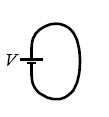Assignment:
Question. This pre-lab explores the characteristics of wires in DC circuits. Keep in mind that an ordinary wire has low but finite resistance. For these questions assume the wire resistance is 0.1 Ohms, the power supply is an ideal 6V voltage source, and the light bulb resistance is 30 Ohms.
A. For the circuit below, one such wire is connected directly across the power supply. What is the voltage drop (in V) across the wire?
The picture of the circuit is basically a 6V battery only attached to a wire with a R of .1 Ohms.
B. Calculate the current (in A) in the wire.
C. In the circuit below, a light bulb (30 ohms) is connected to the power supply using two such wires. Calculate the current (in A) in the circuit.
D. Calculate the voltage drop (in V) across each wire.
E. Calculate the voltage drop (in V) across the light bulb.
F. Now assume the wires in have zero resistance (0 Ohms). Calculate the current (in A) through the light bulb.
G. Again, assuming the wires have zero resistance, calculate the voltage drop (in V) across the light bulb.
H. The last part just basically asks when a current flows through a resistor, does the voltage stay the same, or does the voltage change?
It also asks if the current changes or if the current stays the same.
